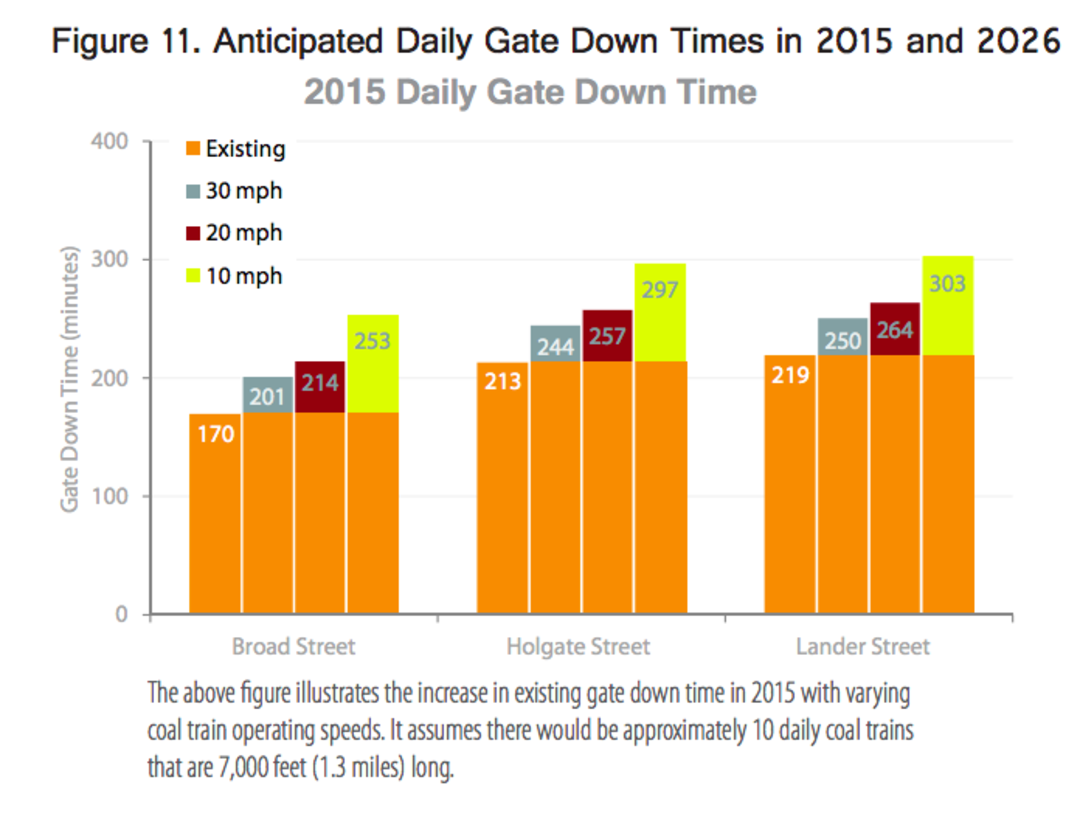City Study: Coal Trains Would Slow Traffic

A $25,000 study commissioned by Mayor Mike McGinn's department of transportation concluded that running as many as 18 mile-long coal trains through along the Seattle waterfront would result in significant additional delays for drivers, emergency responders, and other road users at railroad crossings from SoDo to Belltown.
The amount of delay the study, which McGinn presented with council member Mike O'Brien and consultant John Perlic of Parametrix this afternoon, predicted varies based on how fast the trains are going, but, assuming an average train speed of 20 mph and a train length of 1.6 miles, trains would delay traffic at gate crossings from Belltown to SoDo, on average, a little more than an hour and a half (96 minutes) a day.
The study, by Parametrix—the same firm San Francisco hedge-fund Chris Hansen hired to conduct his own study predicting traffic levels around his proposed arena in SoDo—assumed that trains would pass through Seattle at evenly spaced intervals throughout the day, including morning and evening rush hours, a factor that drove up the average length of the predicted delay. (Longer queues at gate crossings mean longer delays, and, in some cases, could force drivers to sit through more than one train crossing).
Asked why Parametrix decided to assume trains would be passing through Seattle in the middle of rush hour, consultant John Perlic said, "We believe that when the coal trains are loaded, they're going to be loaded and exit that facility [in Wyoming] on a regular type of schedule."
Perlic said Parametrix did not contact Burlington Northern Santa Fe Railroad, which owns the railroad right-of-way, to find out more about the coal trains' likely schedule. "We did not reach out to them," Perlic said. "We had limited time to do the study and we felt like we had enough information to base our assumptions on."
I asked McGinn and O'Brien whether their own ideological and environmental opposition to coal trains played a role in the study's outcome. After all, Parametrix's most recent Seattle study, which focused on the arena that both O'Brien and McGinn support, concluded that the new arena would have virtually no impact on traffic or safety around the arena because people would simply carpool (the study assumed an average of three people per car) or use light rail and walk to the game.
Why would drivers not be able to adjust their behavior similarly to deal with the new trains? And why so much concern for drivers' ability to move through the center city quickly from two men who are dedicated advocates of transit, not driving?
McGinn responded: "This is not ideology. We have a transportation system in which we move freight as well as transit and cars, and we are always looking to optimize that system ... to support all modes" of transportation.
O'Brien echoed, "This isn't some pledge about ideology—this is about being a leader towards a sustainable transportation system. ... This [coal train proposal] doesn't make any sense in the long term or the short term."
The study also looked at current safety conditions from drivers, pedestrians, and bicycle riders at the existing train crossings, but didn't project how many additional collisions or "improper crosssings" (trying to drive around a lowering gate, for example) would be likely with coal trains. However, McGinn said, "I think it’s fair to assume that there will be more frustration from people trying to cross and take advantage of openings" before a train arrived.
